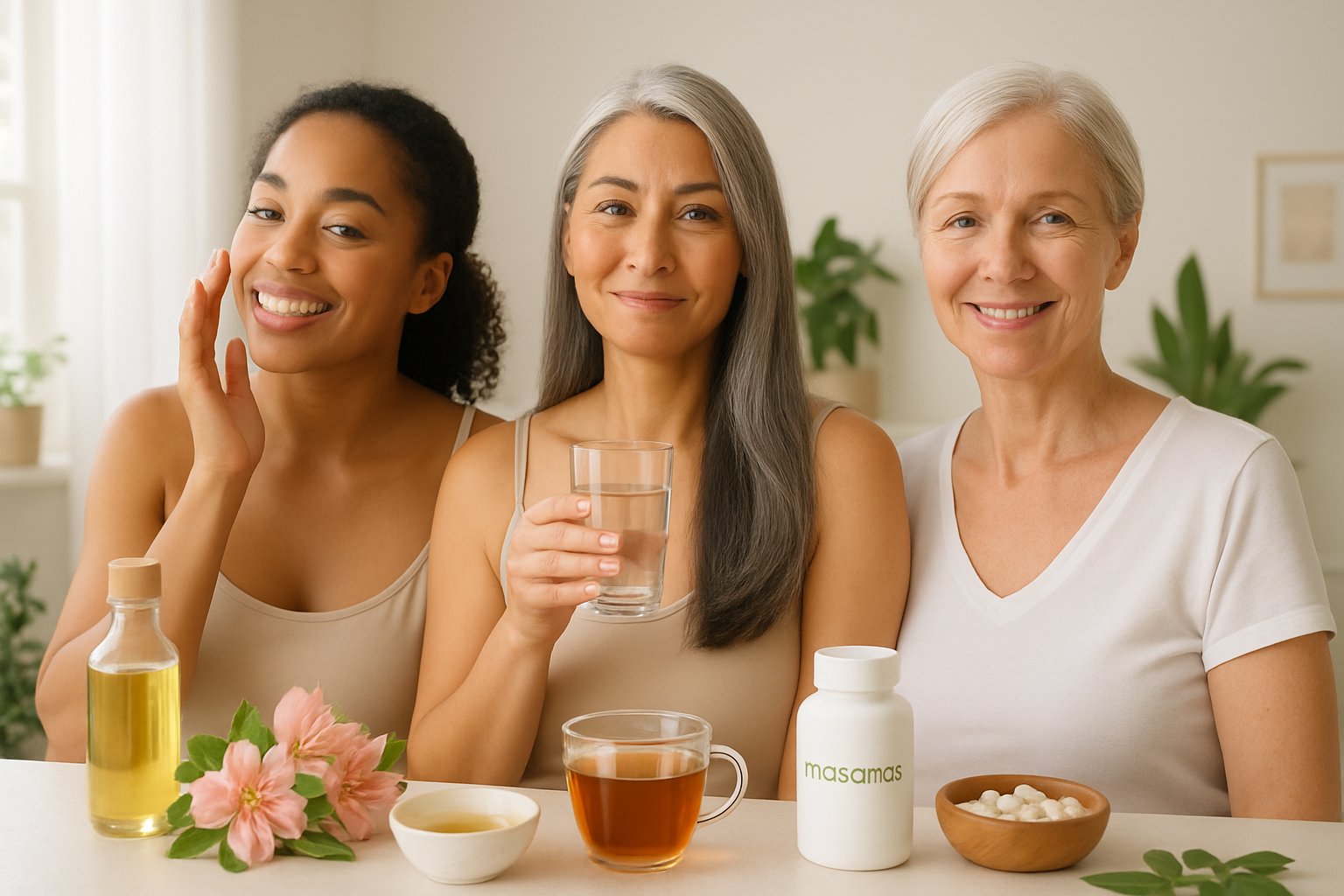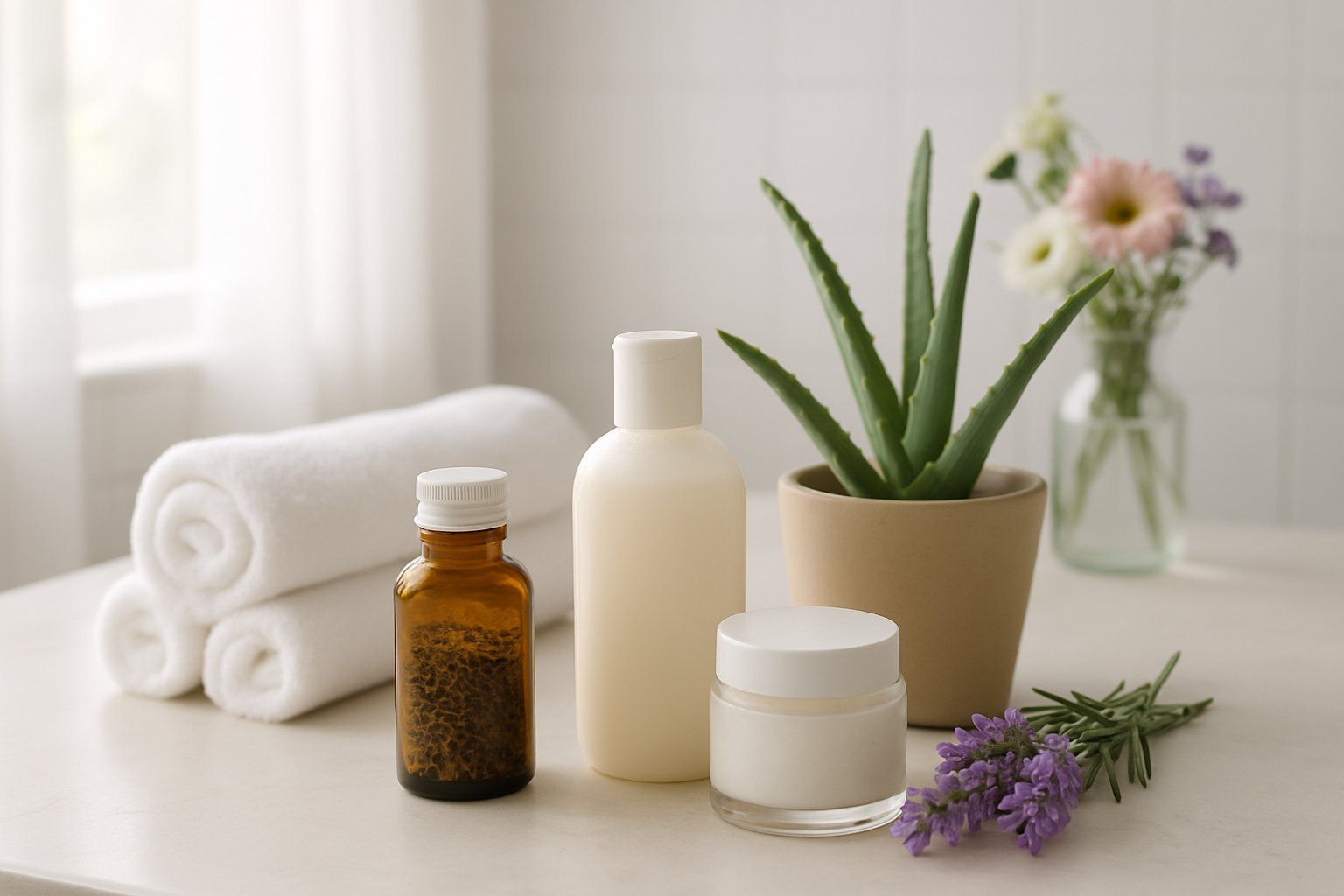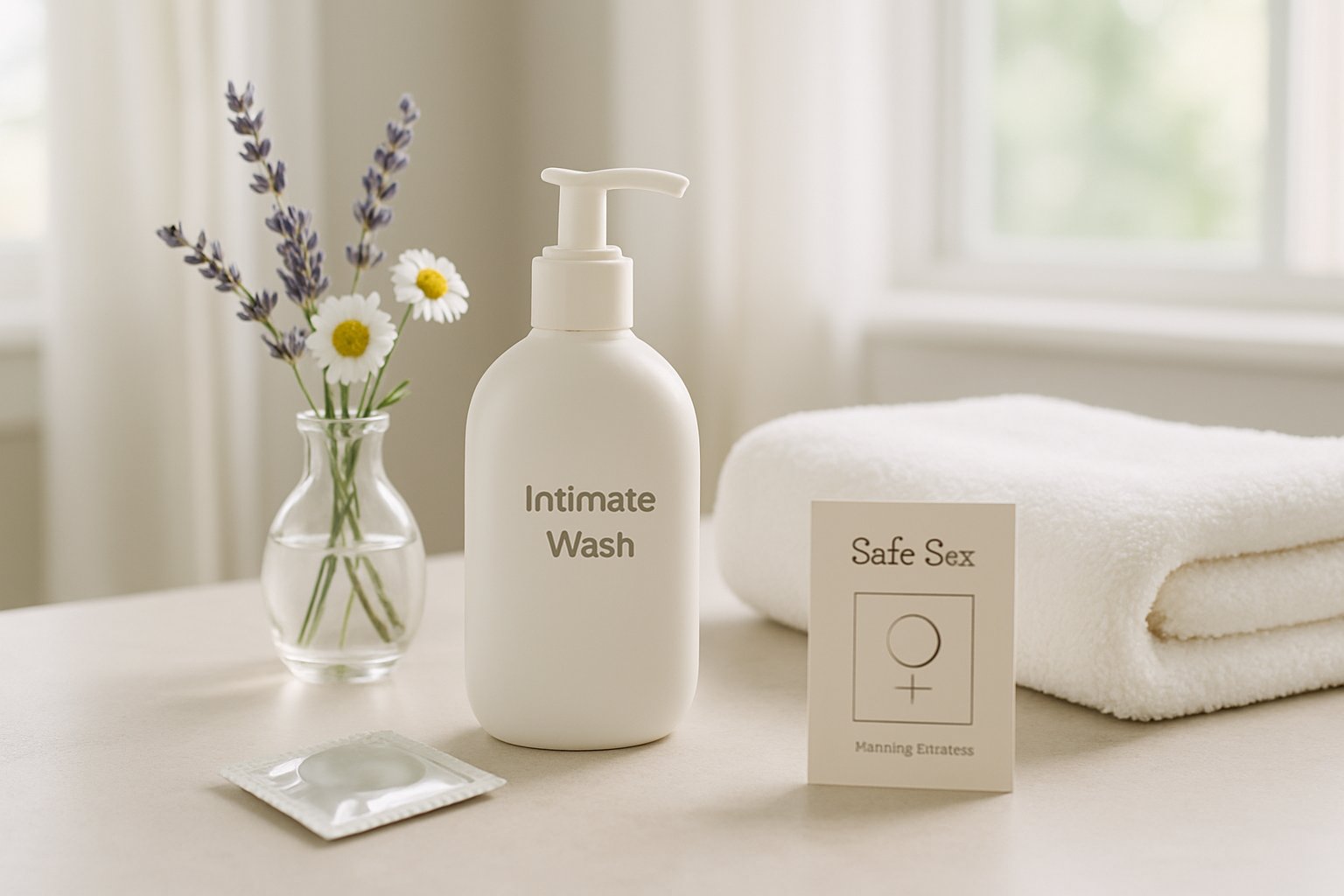Your vagina is designed to maintain itself, but certain daily habits and lifestyle choices can support its natural balance. Simple changes like eating probiotic-rich foods, wearing breathable cotton underwear, and avoiding harsh soaps can significantly improve vaginal health and prevent common issues.

Many women experience vaginal discomfort, unusual discharge, or infections at some point in their lives. These problems often stem from disrupted pH levels, hormonal changes, or practices that interfere with the vagina’s natural ecosystem. Understanding how your body works and what it needs can help you maintain optimal vaginal health[1] naturally.
The good news is that improving vaginal health[2] doesn’t require expensive products or complicated routines. Most effective strategies involve removing harmful habits and supporting your body’s natural processes through proper nutrition, hygiene practices, and stress management.
Key Takeaways
- Supporting vaginal health requires simple daily habits like eating probiotics and wearing breathable fabrics
- Most vaginal issues stem from pH imbalances that can be prevented through proper care and lifestyle choices
- Natural approaches to vaginal wellness are often more effective than harsh products or complicated routines
Understanding Vaginal Health

The vagina is a self-cleaning organ that maintains its health through a delicate balance of bacteria and pH levels. Understanding the difference between the vagina and vulva, plus how healthy bacteria work, helps women make better choices for their reproductive health.
What Is the Vagina and Vulva?
Many people use these terms incorrectly, but the vagina and vulva are different parts of the female anatomy.
The vagina is the internal canal that connects the cervix to the outside of the body. It serves as the birth canal and allows menstrual flow to exit the body.
The vulva includes all the external genital parts. This covers the labia majora, labia minora, clitoris, and vaginal opening.
The clitoris contains thousands of nerve endings and plays a key role in sexual pleasure. It sits at the top of the vulva where the inner lips meet.
The uterus connects to the vagina through the cervix. This muscular organ holds a developing baby during pregnancy.
These structures work together to support reproductive health. The vagina is a self-cleaning organ that requires minimal care[3], making it fairly low-maintenance compared to other body parts.
The Role of Healthy Bacteria
The vagina contains billions of beneficial bacteria that protect against infections and maintain vaginal health.
Lactobacilli make up most of the healthy vaginal bacteria. These good bacteria produce lactic acid and hydrogen peroxide to fight off harmful microorganisms.
The vaginal microbiome includes:
- Lactobacillus crispatus
- Lactobacillus gasseri
- Lactobacillus jensenii
- Lactobacillus iners
These bacteria form a protective barrier against yeast infections and bacterial vaginosis. When healthy bacteria levels drop, harmful organisms can multiply and cause problems.
Factors that disrupt vaginal bacteria include antibiotics, douching, and hormonal changes. Consuming foods with live cultures can help foster a balanced vaginal biome[4].
Vaginal pH Balance and Its Importance
A healthy vaginal pH ranges from 3.8 to 4.5, making it slightly acidic. This acidic environment helps healthy bacteria thrive while preventing harmful organisms from growing.
Why pH balance matters:
- Prevents yeast infections
- Reduces bacterial vaginosis risk
- Maintains natural lubrication
- Supports immune function
When vaginal pH becomes too basic (above 4.5), it creates conditions for infections to develop. Common causes of pH imbalance include menstruation, sexual activity, and certain products.
The vagina’s pH is naturally acidic, which protects against infection and irritation[4]. Douching and harsh soaps can disrupt this delicate balance.
Symptoms of pH imbalance include unusual odor, itching, or changes in discharge. Women who notice these signs should consult their healthcare provider for proper diagnosis and treatment.
Daily Habits to Promote a Healthy Vagina

Simple daily choices can make a big difference in vaginal health. The right hygiene practices, clothing choices, and hydration habits help maintain the vagina’s natural balance and prevent common problems like itching and infections.
Maintain Proper Hygiene
The vagina is naturally self-cleaning[1] and does not need internal washing. Women should focus on cleaning only the external vulva area with warm water and mild, unscented soap.
Feminine hygiene sprays and douching are not necessary[5] and can actually harm the vagina’s natural pH balance. Even products labeled as “sensitive” can disrupt healthy bacteria.
Proper daily hygiene includes:
- Washing the vulva with warm water only or mild unscented soap
- Wiping front to back after using the bathroom
- Changing tampons and pads regularly during menstruation
- Washing hands before touching the genital area
Women should avoid scented products, antibacterial soaps, and bubble baths in the genital area. These products can cause irritation and increase the risk of infections.
Wear Breathable Clothing and Cotton Underwear
Cotton underwear allows air to flow and helps keep the vaginal area dry. Synthetic materials like nylon and polyester can trap moisture and heat, creating conditions where harmful bacteria grow.
Best clothing choices for vaginal health:
- 100% cotton underwear or underwear with a cotton crotch
- Loose-fitting pants and skirts
- Breathable fabrics like cotton and linen
- Avoiding tight jeans or leggings for long periods
Women should change out of wet swimsuits and sweaty workout clothes quickly. Damp clothing can lead to yeast infections and bacterial overgrowth.
Sleeping without underwear gives the vaginal area time to breathe overnight. This practice helps reduce moisture buildup and allows natural air circulation.
Stay Hydrated for Vaginal Health
Drinking enough water helps the body produce natural vaginal lubrication. Proper hydration also supports the immune system’s ability to fight off infections.
Women should aim for 8-10 glasses of water daily. This amount may increase with exercise, hot weather, or illness.
Signs of good hydration include:
- Clear or light yellow urine
- Regular urination
- Moist mouth and lips
- Good energy levels
Limiting caffeine and alcohol helps maintain proper hydration levels. Both substances can cause dehydration when consumed in large amounts.
Staying hydrated supports overall health[3], which directly affects vaginal health. Well-hydrated women often experience fewer urinary tract infections and less vaginal dryness.
Nutrition and Lifestyle for Optimal Vaginal Wellness

Diet plays a key role in maintaining vaginal health by supporting the natural microbiome and pH balance. Specific foods can help reduce infection risk and support the body’s natural defenses.
Eat Fiber-Rich and Whole Foods
Fiber supports vaginal health by strengthening the body’s microbiome and maintaining proper pH levels. Women who eat high-fiber foods have a lower risk of developing bacterial vaginosis[6].
Whole grains provide sustained energy and help maintain stable blood sugar levels. The CDC notes that keeping blood sugar in a healthy range decreases the risk of vaginal problems.
Legumes like beans, lentils, and chickpeas offer both fiber and protein. They support digestive health, which connects to vaginal wellness through the gut-vagina axis.
Sweet potatoes deserve special attention. They contain high amounts of fiber and rank low on the glycemic index. This combination helps balance blood sugar while feeding beneficial bacteria.
Key fiber-rich foods for vaginal health:
- Apples (high fiber, low glycemic)
- Sweet potatoes
- Beans and lentils
- Quinoa and brown rice
- Leafy greens
Include Probiotics and Fermented Foods
Probiotics help maintain the delicate balance of bacteria in the vaginal area. The vagina needs specific good bacteria to fight off harmful organisms and infections.
Yogurt stands out as one of the most beneficial options. Look for unsweetened yogurt with live cultures[6] to get the best probiotic benefits. The bacteria Lactobacillus bulgaricus and Streptococcus thermophilus are particularly helpful.
Fermented foods provide natural probiotics that support the immune system. Kombucha offers antioxidant properties and may decrease inflammation[6].
Other fermented options include:
- Fermented pickles (not brine pickles)
- Aged cheeses like cheddar and parmesan
- Kefir
- Sauerkraut
These foods work by supporting gut health, which connects to vaginal microbiome balance.
The Benefits of Vitamin D and Eggs
Vitamin D plays an important role in immune function and may help prevent vaginal infections. Many women have low vitamin D levels, especially during winter months.
Eggs provide multiple nutrients that support vaginal health. They contain vitamin D, protein, and B vitamins that help maintain healthy tissues.
Vitamin D helps the body absorb calcium and supports the immune system’s ability to fight infections. Low levels may increase susceptibility to bacterial vaginosis and yeast infections.
Ways to increase vitamin D:
- Eat vitamin D-rich foods like eggs and fatty fish
- Spend time in sunlight
- Consider supplements if levels are low
Eggs also provide choline, which supports cell membrane health. The protein in eggs helps maintain and repair vaginal tissues.
Other vitamin D sources include fortified milk, salmon, and sardines. Regular testing can help determine if vitamin D levels need improvement.
Safe Sex and Preventing Infections

Using condoms during sexual activity helps prevent sexually transmitted infections that can disrupt vaginal health. Avoiding harsh products like douches and choosing proper lubricants also protects the vagina’s natural balance.
Practice Safe Sex and Use Condoms
Condoms provide essential protection during sexual activity. They block the exchange of body fluids that carry sexually transmitted infections.
STIs spread through vaginal, anal, and oral sex[7]. Some infections like trichomoniasis directly cause vaginitis and uncomfortable symptoms.
Key benefits of condom use:
- Prevents most sexually transmitted infections
- Reduces risk of bacterial vaginosis
- Protects against trichomoniasis
- Maintains vaginal pH balance
Women should use condoms every time they have sex with new or multiple partners. Even in committed relationships, condoms help if either partner has an active infection.
Latex condoms work best for preventing infections. Non-latex options exist for people with allergies. Female condoms also provide good protection when used correctly.
Avoid Douching and Scented Products
The vagina cleans itself naturally. Douching disrupts this process and increases infection risk.
Douching upsets the natural balance of bacteria[8] in the vagina. This can lead to bacterial vaginosis and yeast infections.
Products to avoid:
- Vaginal douches
- Scented soaps
- Bubble baths
- Vaginal deodorants
- Perfumed pads or tampons
These products contain chemicals that irritate vaginal tissues. They can cause burning, itching, and abnormal discharge.
Instead, women should wash the outside area with warm water and mild, unscented soap. The inside of the vagina does not need cleaning products.
Choose the Right Lubricants
The wrong lubricants can cause irritation and increase infection risk. Water-based or silicone-based options work best for most women.
Avoid lubricants with glycerin, parabens, or numbing agents. These ingredients can disrupt the vagina’s natural pH and encourage bacterial growth.
Safe lubricant choices:
- Water-based without glycerin
- Silicone-based formulas
- Natural options like coconut oil (not with latex condoms)
Oil-based lubricants break down latex condoms. This reduces their effectiveness against STIs and pregnancy.
Women prone to yeast infections should choose lubricants specifically labeled as pH-balanced. These products help maintain the vagina’s acidic environment that prevents harmful bacteria growth.
Always check ingredient lists before purchasing. Simple formulas with fewer chemicals typically cause less irritation than complex products with multiple additives.
Recognizing and Managing Common Vaginal Health Issues

Three main issues affect many women: infections like yeast infections and bacterial vaginosis, urinary tract problems, and dryness that causes discomfort. Each condition has clear signs and proven treatments that work well when used correctly.
Yeast Infections and Bacterial Vaginosis
Yeast infections happen when fungus grows too much in the vagina. Women notice thick, white discharge that looks like cottage cheese. The area feels very itchy and burns during urination.
Common yeast infection symptoms:
- Thick, clumpy white discharge
- Intense itching around the vagina
- Burning feeling when urinating
- Pain during sex
Bacterial vaginosis (BV) occurs when harmful bacteria outnumber good bacteria. Unlike yeast infections, BV causes thin, gray discharge with a strong fishy smell.
BV warning signs:
- Gray or yellow discharge
- Strong fishy odor, especially after sex
- Mild itching or burning
- Pain when urinating
Over-the-counter antifungal creams treat most yeast infections in 3-7 days. BV needs prescription antibiotics from a doctor. Women should see their healthcare provider if symptoms don’t improve or keep coming back.
Urinary Tract Infections and Prevention
UTIs happen when bacteria enter the urinary tract through the urethra. These infections cause pain, frequent urination, and sometimes fever.
UTI symptoms include:
- Burning pain when urinating
- Need to urinate often but only small amounts come out
- Cloudy or strong-smelling urine
- Pelvic pain in women
Prevention works better than treatment. Women should urinate after sex to flush out bacteria. Drinking plenty of water helps keep the urinary tract clean.
- Wipe from front to back after using the bathroom
- Don’t hold urine for long periods
- Drink 6-8 glasses of water daily
- Avoid harsh soaps near the genital area
Cranberry juice may help prevent UTIs but won’t cure an active infection. Doctors prescribe antibiotics to treat UTIs completely.
Vaginal Dryness and Discomfort
Vaginal dryness affects women of all ages but becomes more common during menopause. Low estrogen levels cause the vaginal walls to become thin and produce less moisture.
Signs of vaginal dryness:
- Pain or discomfort during sex
- Light bleeding after intercourse
- Itching or burning around the vagina
- More frequent UTIs
Vaginal moisturizers provide long-term relief when used regularly. Water-based lubricants help during sexual activity. Women should avoid products with fragrances or harsh chemicals.
Treatment options:
- Over-the-counter moisturizers: Use 2-3 times per week
- Water-based lubricants: Apply before sexual activity
- Hormone therapy: Available by prescription for severe cases
Vaginal health conditions[9] can cause ongoing discomfort that affects daily life. Women experiencing persistent symptoms should talk to their healthcare provider about the best treatment options.
Hormonal and Life Stage Factors

Hormones directly impact vaginal pH, moisture levels, and bacterial balance throughout a woman’s life. Monthly cycles, menopause, and hormone treatments create significant changes that require specific care approaches.
Menstruation and Its Effects
The menstrual cycle creates constant changes in vaginal health. Estrogen and progesterone levels shift throughout the month, affecting pH balance and natural lubrication.
During menstruation, blood raises vaginal pH from its normal acidic range of 3.8 to 4.5. This temporary change can disrupt the protective bacterial environment.
Menstrual Phase Challenges:
- Higher pH levels reduce natural defenses
- Blood creates breeding grounds for harmful bacteria
- Tampon and pad use can cause irritation
- Increased risk of yeast infections
The follicular phase brings rising estrogen levels. This hormone thickens vaginal walls and increases natural lubrication. Hormones regulate the menstrual cycle and shape the vaginal environment[10].
During ovulation, cervical mucus changes consistency. The luteal phase sees progesterone dominance, which can reduce moisture and change bacterial balance.
Women should change tampons or pads every 4-6 hours during menstruation. Avoiding scented products helps maintain natural pH levels.
Vaginal Health During Menopause
Menopause brings dramatic hormonal changes that significantly affect vaginal health. Estrogen levels drop by 90% or more, creating lasting physical changes.
Low estrogen causes vaginal walls to become thinner and less elastic. This condition, called vaginal atrophy, affects up to 50% of postmenopausal women.
Common Menopausal Changes:
- Reduced natural lubrication
- Vaginal dryness and irritation
- Narrowing of the vaginal opening
- Higher pH levels (above 5.0)
- Increased UTI risk
The vaginal lining loses its protective layers without adequate estrogen. This makes tissues more prone to tearing and infection.
Menopause becomes a shift where hormone production flatlines[11]. Women typically reach menopause around age 51.
Regular sexual activity or vaginal moisturizers can help maintain tissue health. Water-based lubricants reduce friction during intercourse.
Some women experience symptoms years before periods stop completely. This perimenopause phase can last 4-10 years.
Hormone Replacement Therapy and Treatments
Hormone replacement therapy (HRT) can restore vaginal health in menopausal women. Estrogen treatments help rebuild vaginal tissues and restore natural moisture.
HRT Options for Vaginal Health:
- Topical estrogen creams
- Vaginal estrogen rings
- Estrogen tablets (inserted vaginally)
- Systemic hormone patches or pills
Local estrogen treatments work directly on vaginal tissues. These options have minimal absorption into the bloodstream compared to systemic treatments.
Bioidentical hormone therapy uses compounds that match the body’s molecular structure[11]. This approach may reduce side effects compared to synthetic hormones.
Vaginal estrogen typically shows improvements within 2-3 weeks of use. Symptoms like dryness and painful intercourse often resolve with consistent treatment.
Non-hormonal options include vaginal moisturizers and lubricants. These products provide temporary relief but don’t address underlying tissue changes.
Women with breast cancer history may need alternative treatments. Healthcare providers can recommend appropriate options based on individual medical history.
Regular follow-up appointments help monitor treatment effectiveness and adjust dosages as needed.
When to Seek Professional Help

Knowing when to contact a healthcare provider can prevent serious health issues and ensure proper treatment. Regular checkups and awareness of warning signs help maintain optimal vaginal health throughout life.
Regular Gynecological Exams
Women should schedule routine gynecological visits even when feeling healthy. These appointments help catch problems early and maintain preventive care.
Recommended Visit Schedule:
- Ages 21-29: Every 1-3 years for Pap smears
- Ages 30-65: Every 3-5 years depending on test results
- Over 65: As recommended by healthcare provider
Regular screenings help detect cervical cancer[1] and other reproductive health issues. Healthcare providers can adjust screening schedules based on individual risk factors.
Annual wellness visits allow discussion of birth control options, sexual health concerns, and menopause symptoms. These appointments provide opportunities to ask questions about normal changes.
Unusual Symptoms and When to See a Healthcare Provider
Certain symptoms require immediate medical attention. Women should not ignore changes that persist or cause discomfort.
Contact a healthcare provider for:
- Pain during sexual intercourse
- Unusual vaginal discharge with strong odor
- Persistent itching or burning
- Bleeding between periods or after sex
- Bleeding after menopause[1]
Vaginal infections often cause noticeable symptoms. Yeast infections, bacterial vaginosis, and sexually transmitted infections need proper diagnosis and treatment.
New lumps, bumps, or masses in the vaginal area require evaluation. Changes in discharge color, consistency, or smell may indicate infection.
Cancer and Long-Term Health Considerations
Cervical cancer screening remains crucial for early detection. HPV vaccination significantly reduces cancer risk when given at recommended ages.
Regular Pap smears can detect precancerous changes before they become serious. Most cervical cancers develop slowly over many years.
Warning signs that need evaluation:
- Persistent pelvic pain
- Unexplained weight loss
- Unusual bleeding patterns
- New onset urinary problems
Women with family history of reproductive cancers may need more frequent screening. Healthcare providers can recommend genetic counseling when appropriate.
Early detection dramatically improves treatment outcomes for most gynecological cancers. Never delay seeking care for concerning symptoms that persist longer than a few days.
Frequently Asked Questions

Many people have questions about specific vitamins, natural remedies, and daily practices that support vaginal wellness. Understanding which nutrients matter most and how to maintain proper pH balance can help prevent common issues.
What are the best vitamins and nutrients to enhance vaginal health?
Probiotics are the most important nutrients for vaginal health. These live cultures help maintain healthy bacteria in the vaginal area.
Vitamin D supports immune function and may help prevent infections. Vitamin C also strengthens the immune system and helps fight harmful bacteria.
The best vitamins for vaginal health[12] should contain science-backed ingredients without unnecessary additives. Look for supplements that include lactobacillus strains.
B vitamins, especially B6 and B12, support overall reproductive health. Folic acid is also important for women of childbearing age.
What natural remedies help maintain vaginal cleanliness and a pleasant odor?
Boric acid suppositories are one of the most effective natural remedies for odor and cleanliness. Healthcare providers often recommend them for bacterial vaginosis that resists antibiotics.
Sitz baths with plain warm water can help with itching and discomfort. Fill a bathtub with just a few inches of water and sit for 10-15 minutes.
Tea tree oil should be heavily diluted if used at all. Many experts recommend avoiding it since it can cause irritation.
Apple cider vinegar baths may help restore pH balance. Add one cup to a warm bath, but never apply it directly to the vaginal area.
Which foods are beneficial for maintaining optimal vaginal health?
Foods with live cultures are the most important for vaginal health. Yogurt, kimchi, sauerkraut, and kefir contain beneficial bacteria.
Water helps flush out harmful bacteria and may reduce urinary tract infections. Staying hydrated supports overall vaginal health.
Nuts and legumes may help prevent bacterial vaginosis according to some studies. Include almonds, beans, and lentils in your diet.
Soy products like soymilk and edamame might reduce vaginal dryness. However, more research is needed to confirm this benefit.
Limit added sugars, which can feed harmful yeast and bacteria. Avoid excessive alcohol consumption as well.
What hygiene practices are recommended for good vaginal health?
The vagina cleans itself naturally, so gentle practices work best. Use only warm water to clean the external vulvar area.
Avoid douching completely, as it disrupts natural pH levels and beneficial bacteria. This practice can increase infection risk.
Wipe front to back after using the bathroom. This prevents bacteria from the anal area from reaching the vagina.
Change out of wet clothes quickly, including swimsuits and workout gear. Moisture creates an environment for harmful bacteria to grow.
Urinate after sexual activity to flush out any bacteria that may have entered the urinary tract.
How can you naturally balance vaginal pH to reduce unpleasant odors?
The healthy vaginal pH should be between 3.8 and 4.5, which is slightly acidic. This acidity prevents harmful bacteria from growing.
Probiotics help maintain proper pH by supporting good bacteria. Take supplements or eat fermented foods daily.
Avoid scented soaps, washes, and feminine sprays. These products can disrupt natural pH balance and cause irritation.
Boric acid suppositories can help restore pH when it becomes too alkaline. Use them only as directed and avoid during pregnancy.
Cotton underwear allows better airflow than synthetic materials. This helps maintain the right moisture and pH levels.
What are effective products for promoting vaginal health?
Cotton underwear is the best choice for daily wear. It breathes better than synthetic fabrics and reduces moisture buildup.
Lubricants without glycerin or sugar prevent yeast infections during sexual activity. Choose water-based or silicone-based options.
Probiotic supplements with lactobacillus strains support healthy vaginal bacteria. Look for products specifically designed for women’s health.
pH test strips can help monitor vaginal acidity levels at home. Normal readings should be between 3.8 and 4.5.
Gentle, unscented laundry detergent protects sensitive skin. Harsh chemicals in regular detergents can cause irritation.
References
- Tips To Keep Your Vagina Healthy. https://health.clevelandclinic.org/how-to-keep-your-vagina-happy-healthy Accessed October 20, 2025
- How to Improve Vaginal Health Naturally | Board Certified Internist located in Houston, Dallas, Fort Worth, Austin, San Antonio and Victoria, TX. https://www.myhomedoc.care/post/how-to-improve-vaginal-health-naturally Accessed October 20, 2025
- 10 Ways to Look After Your Vaginal Health. https://www.evvy.com/blog/vaginal-health Accessed October 20, 2025
- How to Improve Vaginal Health: Tips and Practices. https://www.everlywell.com/blog/virtual-care/how-to-improve-vaginal-health/ Accessed October 20, 2025
- Feminine hygiene sprays and douching are not necessary. https://www.plannedparenthood.org/uploads/filer_public/a4/7e/a47ef658-65ea-4109-a6cd-ac0bb1ac4f20/keeping_your_vagina_healthy_brochure_english.pdf Accessed October 20, 2025
- 11 Best Foods For Vaginal Health, According to Dietitians. https://www.usenourish.com/blog/best-foods-for-vaginal-health Accessed October 20, 2025
- STIs spread through vaginal, anal, and oral sex. https://www.publichealth.va.gov/docs/womens-health-guide/safer-sex.pdf Accessed October 20, 2025
- 403 Forbidden. https://www.jeffersonhealth.org/your-health/living-well/how-preventable-is-vaginitis Accessed October 20, 2025
- How To Treat The Discomfort Of Vaginal Health Conditions Without The Stigma. https://www.henryford.com/blog/2024/06/vaginal-health-conditions Accessed October 20, 2025
- Fertility, Hormones, and Vaginal Health: What’s the Connection?. https://www.evvy.com/blog/fertility-hormones-and-vaginal-health-whats-the-connection Accessed October 20, 2025
- Female Hormonal Health Guide: Support at Every Life Stage. https://www.next-health.com/post/thriving-through-hormonal-shifts-a-modern-guide Accessed October 20, 2025
- The 6 Best Vitamins For Vaginal Health & pH Balance (2025)*. https://www.mindbodygreen.com/articles/best-vitamins-for-vaginal-health Accessed October 20, 2025
